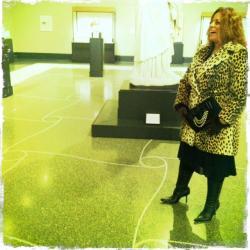Spring has sprung, everything is in bloom, and I’m noticing honeybees, especially in the tiny blue-gray flowers of the miles of rosemary which grows along the Chandler Bikepath in Burbank.
For the past few years, we’ve been hearing dire predictions of apiary apocalypse. Colony Collapse Disorder, or the disappearance of honeybees, has been blamed on everything from electromagnetic disturbance caused by cell-phones, to the antibiotics used by commercial bee-keepers.
But here’s hope from Silverlake: Feral brand honey (www.feralbee.com). It’s collected by Russell and Amy Bates from their four backyard hives. The bees which produce it aren’t all hopped up on sugar-water, or high-fructose corn syrup, like factory bees. Feral bees sup on the nectar of blooming random flowers, like bees in children’s books. Bates estimates that the bees in his hives forage around in blossoms throughout a three-mile radius from the hives, and their nectar-menu changes throughout the year, depending upon what is in bloom. Thus, the flavors of Feral honey are always subtly changing, too.
Feral brand honey is never heated or filtered. This distinguishes it from the golden liquid sold as honey in supermarkets. Processing honey removes the pollen, which, according to Food Safety News, is what contains honey’s nutrients: amino acids, fats, vitamins, minerals. Take out the pollen, and the rest is just sugar.
I’m no melissopalynologist, but there’s even more disturbing news. Removing the pollen also removes any way to identify the honey’s place of origin. There is now such a thing as, ha-ha, honey-laundering, which isn’t funny, honey. Lots of cheap honey from industrially bred bees originates in China, and finds its way to US shelves. Some sticky regulations may force the Chinese suppliers to pass-through, sending to honey to market via a secondary market such as India, Vietnam, Malaysia or Thailand, adding intrigue, but no nutritional value.
The low price of this Asian honey forces small US beekeepers out of business, but that’s not the worst part. Chinese honey is notorious for its contaminants, which often include animal antibiotics and heavy metals.
Some US brands claim that they ultrafilter and process their honey to prolong its shelf-life, and to give American consumers the super-clear product that they say they want. In the process, these big brands also make it impossible to know where the honey was cultured and collected.
The bees in Russell Bates’ backyard were captured as swarms there in his neighborhood. Bates is a Darwinist, and practices “Backwards Beekeeping”, meaning hands-off and let nature take its course.
To taste Feral honey, check out the Village Bakery & Cafe and Canele restaurant in Atwater Village. Barbrix also uses Feral honey in prosecco cocktail specials, and Bar Covell in Los Feliz offers a dab of this apian amber as part of its gourmet cheese plate.
–Victoria Thomas




Is there a service to relocate inconvenient bee hives (like over my front door)?